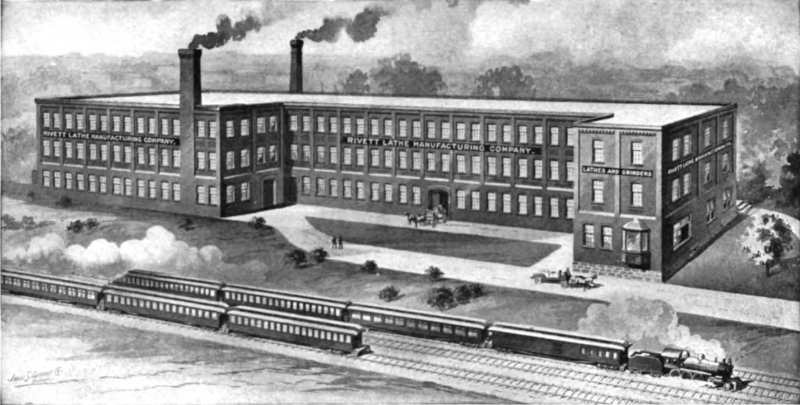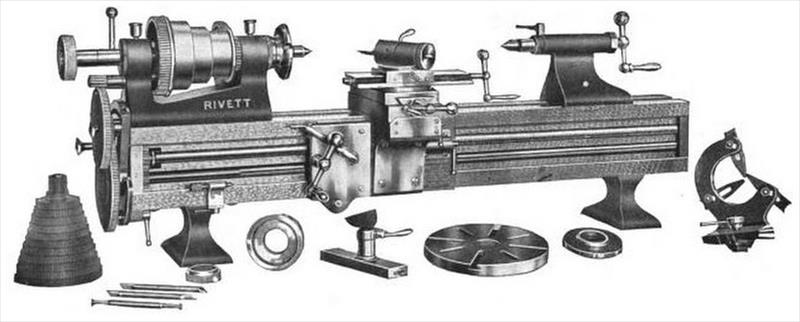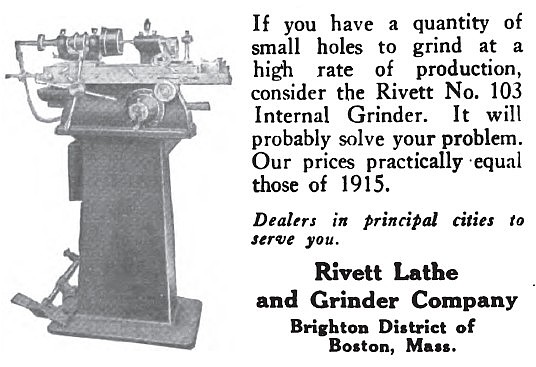 |
| From Nov. 7, 1907 American Machinist |
Edward Rivett's early career was spent as a watchmaker. In 1884, he and fellow watchmaker C. A. W. Crosby established the Faneuil Watch Tool Co., and introduced a watchmaker's lathe and, in about 1888, a bench lathe, along with small tools for jewelers and watchmakers. The lathes and staking tools were very successful and by 1892 the company had expanded into a much larger factory.
Where their competition sold a watchmaker's lathe for $40 or even less, the Faneuil lathe was $60, $110 with compound slide rest. In 1893 the company introduced a reduced-cost model, the "Crosby Lathe", priced at $45. This hints at a point of friction between Rivett and Crosby: Rivett emphasized quality over quantity and we suspect Crosby argued that that was to the detriment of the business.
C. A. W. Crosby died in April of 1894. Rivett continued the business along with C. A. W.'s son, John D. Crosby, who became treasurer. In 1896 the company introduced the larger and meticulously crafted No. 4 bench lathe, which sold for a whopping $500. In about 1902 the company incorporated as Faneuil Watch Tool Co., Inc. In 1903 Rivett bought out C. A. W. Crosby's heirs and renamed the company to the Rivett Lathe Manufacturing Co. Over the next couple of years the "Faneuil Watch Tool" name was phased out from ads and articles. In 1906 Rivett sold the staking tool business to focus on the lathes, solidifying the shift in focus already seen in the company name.
By 1911, Rivett was proudly advertising that theirs were the highest priced bench lathes in the world, and although they were still making watchmakers' lathes, the focus had shifted to the broader machine tool market. The company also claimed that they were having trouble keeping up with orders.
 |
| Rivett 8-inch precision lathe, from 1913-01-02 American Machinist |
In 1912 the company was purchased by a group of financial people and Edward Rivett retired from the business, apparently for health reasons (though he lived another quarter century). The company name changed to the Rivett Lathe & Grinder Co., with W. H. Shafer, formerly of Cincinnati-Bickford, joining the business as vice president and general manager. The run-up to the war was a busy time for the company, and during the war years the company peaked at over 200 employees. Despite the depression in the machine tool industry following the end of the war, in 1920 the company invested in a factory expansion that doubled its capacity. The following year the company entered receivership.
By October 1921 the company had less than a dozen workers. In May of 1923, the company was refinanced and reorganized as the Rivett Lathe & Grinder Corp. At some point during this era the watchmakers' lathe line was sold to F. W. Derbyshire of Shrewsbury, Massachusetts.
 |
| From 1922-10-05 American Machinist |
The following decades saw a series of new models being introduced: bigger models, lower-cost models, quick-change gearbox and power feed, integrated belt-drive motor, turret model, etc. In 1941 they introduced a new toolroom lathe model but production was discontinued in 1942 as the company concentrated their wartime efforts on their most popular models. Following the end of the war they started developing an all-new watchmaker's lathe, the 1R, which was introduced in 1948. The 1R sold modestly and was discontinued after a few years. However, their updated 1020/1030R toolroom lathe, introduced at the same timee as the watchmaker's lathe, were more successful. These lathes were bigger, heavier, stronger, and more full-featured than the Monarch 10EE and the Hardinge HLV, and were priced accordingly. About 400 were sold over the next 18 years. These lathes are very desirable as long as they are in good condition: a rebuild of these complex and meticulously precise lathes is extremely expensive.
By the 1960s the company had fallen on hard times. Buyers for their expensive lathes were hard to find and other lines of business, including hydraulic components, were not enough the sustain the company. The hydraulic valve line was sold off and the remaining hydraulic business, their Dynex division, became Dynex/Rivett. In 1966 the company was acquired by Applied Power Industries, Inc., which sold the machine tool part of the business to Leland-Gifford Co., becoming the Rivett Machine Tool Division of Leland-Gifford Co. The following year Leland-Gifford was acquired by appliance conglomerate White Consolidated Industries, which had little interest in the cyclical and low-margin business of making precision machine tools. The Rivett division operated for a while as Rivett Lathes and Grinders from Leland-Gifford subsidiary of White Consolidated Industries, Inc. The machine tool business was eventually transferred to the Fay-Scott Division of White Consolidated and then shut down. Within a few years all the records, drawings, patterns and spares had been discarded in a landfill, a sad end for one of the most highly respected machine tool makers.
Information Sources
- American Lathe Builders: 1810-1910 by Kenneth L. Cope, 2001 page 48
- The Massachusetts corporate registry database lists this company's first registration as 1896-11-11.
- The Rivett Lathe site is an unofficial site devoted to this maker. It has good historical information on the company and their products, and much of the history presented above has been found on this site.
- The Massachusetts corporate registry database lists Rivett Lathe & Grinder Co.'s first registration as 1912-06-26. The first registration of Rivett Lathe & Grinder Corp. was 1923-05-01. The first registration of Rivett Lathe & Grinder, Inc. is also shown as 1923-05-01, but that may be in relation to the earlier name; another date associated with the "Inc." name is 1934-12-21.
- 1921-06-30 American Machinist lists "Rivett Lathe & Grinder Co., Boston" as makers of grinding machines, cutter and reamer grinders, radial grinding machines, gage grinding machines, internal grinding machines, bench lathes, threading lathes, lathe attachments, and polishing and buffing machines.
- Brochure dated 1934-01-22 from Rivett Lathe & Grinder Corp., for a Blanchard pulsolator.
- 1954 brochures from Rivett Lathe & Grinder, Inc., for an armature turning lathe and the Rivett 928 Steelway precision cabinet lathe.
- Directory of Metalworking Machinery, 1951, pg. 36